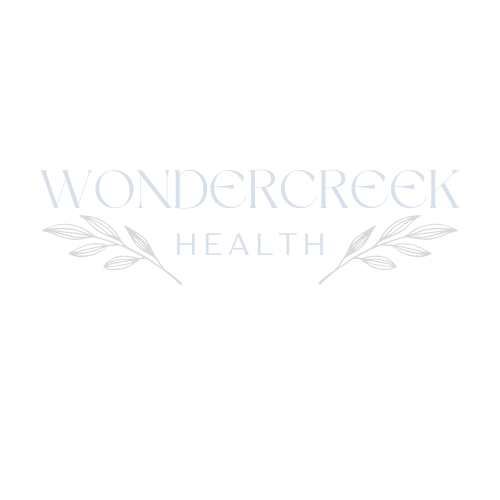The Lesser-Known Symptoms of Menopause: You're Not Crazy, It’s Just Perimenopause
Anna Harrelson • February 10, 2025
Unraveling the Mystery of Menopause: The Symptoms No One Warned You About

Hot flashes and night sweats get all the attention when it comes to menopause, but what about the symptoms that no one warns you about? The ones that leave you wondering if you have 27 different diagnoses when, in reality, it’s all just perimenopause? If you’ve been feeling off and struggling to connect the dots, you’re not alone. Let’s break down some of the lesser-known symptoms of perimenopause and menopause, why they happen, and what you can do about them.
The Wild Ride of Hormonal Shifts: It’s Not Just Declining Estrogen
Before we dive in, let’s get one thing straight: menopause symptoms aren’t just about a steady decline in estrogen, testosterone, and progesterone. It’s the erratic, unpredictable rollercoaster of hormonal shifts during perimenopause that wreaks the most havoc. Many symptoms that peak during perimenopause stabilize once estrogen levels even out after menopause. However, that doesn’t mean they disappear completely—even with menopausal hormone therapy (MHT), some symptoms persist, just with less intensity.
The Symptoms No One Talks About (But We Should)
1. Breast Size Changes
Your breasts might feel fuller, lumpier, or even shrink as estrogen and progesterone levels fluctuate. Many women notice that their cup size changes due to changes in breast tissue composition and fat distribution. Tenderness is also common, especially in perimenopause when hormone levels are fluctuating wildly.
2. Burning Mouth Syndrome
Yes, this is a real thing. Some women experience a burning sensation in their tongue, lips, or gums, likely due to declining estrogen affecting nerve function and saliva production.
3. Electric Shock Sensations
Ever felt like you’re being zapped by an invisible force? Sudden, brief electrical shock sensations are a weird but real symptom of menopause, thought to be linked to nerve instability caused by estrogen fluctuations.
4. Skin Crawling and Itchiness
If your skin suddenly feels like bugs are crawling on it, or you’re itching more than usual, fluctuating estrogen could be to blame. Estrogen plays a role in collagen production and skin hydration, so its decline can cause dryness, sensitivity, and that creepy-crawly feeling.
5. Digestive Issues
Bloating, gas, changes in bowel habits—estrogen and progesterone directly impact gut motility, microbiome balance, and inflammation. Perimenopause often brings IBS-like symptoms that settle once hormone levels stabilize.
6. Bladder and Urethral Symptoms
Frequent UTIs, urgency, or even a weird tingling sensation in your urethra? The bladder and urethra are estrogen-sensitive tissues, so they can become irritated, dry, and inflamed with hormone changes.
7. Body Odor Changes
Some women notice their scent changes, even if they haven’t switched deodorants. Shifts in hormone levels affect sweat gland activity, sometimes making body odor stronger or just different.
8. Tinnitus (Ringing in the Ears)
Fluctuations in estrogen impact circulation and nerve function, which can contribute to ringing or buzzing in the ears.
9. Increased Histamine Sensitivity
Ever feel like your allergies are suddenly worse? Estrogen affects mast cells, which are responsible for histamine release. Fluctuating estrogen can make you more prone to hives, flushing, and histamine-related reactions.
10. Anxiety and Sudden Panic Attacks
You were never an anxious person before, so why does it feel like you’re constantly on edge? Estrogen directly impacts neurotransmitters like serotonin and dopamine, and when it swings wildly, so does your mood.
11. Joint Pain and Stiffness
Estrogen has anti-inflammatory properties, so its decline contributes to increased joint pain, stiffness, and even the onset of inflammatory conditions like frozen shoulder.
How Hormone Therapy and Lifestyle Changes Can Help
While many of these symptoms improve as hormones stabilize, the reality is that you don’t have to suffer through them without support. Let’s talk about what actually helps.
Menopausal Hormone Therapy (MHT): Replacing estrogen, progesterone, and even testosterone can help significantly with many of these symptoms, especially those related to nerve function, skin, and bladder health. However, MHT won’t make all symptoms vanish overnight—it’s about stabilizing the hormonal rollercoaster and reducing severity.
Oral Contraceptives for Perimenopause: If you’re still cycling and experiencing extreme symptom fluctuations, oral contraceptives can suppress ovulation and override hormonal chaos, making symptoms much more manageable.
Lifestyle Adjustments That Matter:
Anti-Inflammatory Diet: Eating whole, nutrient-dense foods supports gut health, reduces histamine sensitivity, and minimizes inflammation that contributes to joint pain and digestive issues.
Strength Training & Movement: Regular exercise helps with joint pain, muscle loss, and hormone balance. Strength training in particular helps combat estrogen-related muscle deterioration.
Hydration & Electrolyte Balance: Dehydration can make symptoms like dizziness, joint pain, and histamine intolerance worse.
Stress Management & Sleep Hygiene: Poor sleep and chronic stress exacerbate many menopause symptoms. Prioritizing rest and relaxation is crucial.
You’re Not Broken—You’re in Perimenopause
If you’ve been dismissed by doctors, told your symptoms are unrelated, or prescribed multiple medications for what is actually a single hormonal transition, know this: you are not alone. Perimenopause and menopause can make you feel like a stranger in your own body, but there is hope. Understanding what’s happening and having a plan—whether that includes MHT, lifestyle modifications, or a combination of both—can make all the difference.
If you’re struggling and want personalized support, I’m here to help. Let’s work together to navigate this transition with clarity, confidence, and solutions that actually make a difference in your life. Because you deserve to feel like you again.
WonderCreek Health Blog

You’re not crazy. You’re not lazy. And no, you’re not just "getting older." If you’re dragging through your days, feeling foggy, heavy, or worn out—but your labs are "normal"—you’re not alone. One of the most overlooked causes I find in my practice is suboptimal ferritin levels. Let’s break it down—with science, a little wit, and a whole lot of hope. Your Body: A High-Performance Machine Imagine your body like a beautifully engineered, high-performance car. Hormones are your spark plugs. Micronutrients are your engine oil. Proteins are your gears and pulleys. Without the right balance of all these building blocks, the engine sputters. It doesn’t matter how good the outside looks—if you're low on fuel or missing key fluids, you’re not getting out of the driveway. And iron —stored as ferritin—is a huge part of that fuel system. What Is Ferritin, and Why Should You Care? Ferritin is your body's iron storage protein. It’s like your gas tank. Not your current speed, not your miles per gallon—your actual reserve of fuel. Iron is essential for carrying oxygen to every cell in your body. It's crucial for energy production (ATP) in your mitochondria. It supports your thyroid, neurotransmitter function, hair growth, immune system, and even mood. If you’re low on ferritin, you might still show " normal " hemoglobin or hematocrit—so traditional screening won’t catch it until you’re running on fumes. Symptoms of suboptimal ferritin can include: Fatigue and poor exercise tolerance Brain fog or poor concentration Mood swings or low mood Headaches Hair shedding Shortness of breath with minimal exertion Restless legs or poor sleep Sound familiar? But My Labs Say I'm Normal... Here's the kicker: most lab ranges are designed to flag anemia — not optimal function. You could have a ferritin of 12 and be told " everything looks fine " — but feel absolutely awful. For most women, especially those who are still menstruating or recently stopped, ferritin levels under 40–60 ng/mL can cause symptoms . Many functional and integrative medicine specialists aim for 70–100+ ng/mL to support optimal energy, cognition, and hair health. Low-normal is not optimal. When your engine light is blinking, topping off the tank halfway doesn’t cut it. Why You Might Be Low Menstruation: Every period can deplete iron stores, especially if cycles were heavy. Pregnancy and postpartum: Even years later, many women never rebuild their iron stores. Gut health issues: Poor absorption due to low stomach acid, celiac disease, or IBS. Dietary patterns: Plant-based diets can be low in easily absorbed heme iron. Chronic inflammation: Inflammatory signals can "hide" your iron from circulation. Food First, But Realistic Yes, food matters. Red meat, poultry, seafood, lentils, spinach, and pumpkin seeds all contribute iron. But rebuilding storage? That’s a bigger lift. Think of dietary iron like filling up your gas tank 10–15% at a time. Helpful, but slow if you're starting on empty. Sometimes you need a boost. That’s where targeted supplementation can help—whether it’s gentle oral iron (like iron bisglycinate) or occasional intravenous iron if needed. And by the way, ever wonder why "senior" vitamins have no iron? Because postmenopausal women typically don’t lose blood monthly. We don’t want too much iron. But we also can’t function with too little. Balance is everything. Final Thoughts If you’re feeling run down, foggy, achy, or unlike yourself—it’s not "all in your head." Your body is whispering (or screaming) for better support. And sometimes the missing piece isn’t fancy. It’s basic, foundational, and fixable. Ferritin matters. Iron matters. You matter. At Wondercreek Health, I believe in digging deeper, connecting the dots, and helping you rebuild the strong, steady foundation your body deserves. Because you weren’t designed to run on empty. Iron-Rich Foods to Boost Your Levels Beef, lamb, liver (heme iron is best absorbed) Dark poultry (chicken thighs, turkey) Shellfish (clams, oysters, mussels) Lentils and chickpeas Spinach and swiss chard Pumpkin seeds and cashews Fortified cereals and oatmeal Tofu and tempeh Tip: Pair iron-rich foods with vitamin C (like bell peppers, oranges, or strawberries) to boost absorption! Ferritin Target Chart Ferritin Level What It Means <15 ng/mL Severe deficiency 15–40 ng/mL Low stores (symptoms likely) 40–60 ng/mL Borderline (may still have symptoms) 70–100+ ng/mL Optimal for energy, cognition, hair health Individual needs vary—always interpret ferritin in the context of your full health picture! When to Suspect Low Iron Feeling tired despite good sleep Exercise feels harder than it used to Brain fog or poor memory Unexplained hair thinning Pale skin or brittle nails Frequent headaches Restless legs or poor sleep Shortness of breath climbing stairs If you’re nodding along to several of these, it’s worth a closer look at your ferritin levels.

Let’s start with this: there is nothing shameful or trivial about wanting a healthy sex life. If you're in your 30s, 40s, 50s, or beyond and wondering where your libido went, why sex feels different (or uncomfortable), or why no one ever warned you about vaginal dryness, you’re not alone. And you’re not imagining it. At Wondercreek Health, I talk to people every week who feel confused, dismissed, or ashamed about the sexual changes happening in their bodies. Many are thriving in every other area of life—careers, caregiving, health—but when it comes to intimacy, they feel stuck or unseen. So let’s say this together: sexual health is part of whole-person health. And pleasure is not optional . It’s a reflection of nervous system safety, hormonal balance, connection, and self-awareness. It belongs to you. What Happens to Sexual Health in Midlife and Beyond? Hormonal shifts during perimenopause and menopause can affect every part of your sexual experience. But so can chronic stress, birth control, antidepressants, trauma, and the weight of daily responsibilities. This is never just one thing. Common symptoms include: Vaginal dryness, burning, or itching (genitourinary syndrome of menopause, or GSM) Pain with sex (dyspareunia) Loss of libido or arousal Less intense or harder-to-reach orgasms Urinary urgency or UTIs Pelvic floor tension or dysfunction These changes aren’t "just in your head" and they’re not a moral failure. They reflect real shifts in tissue, blood flow, hormones, and brain chemistry. Sex Isn’t Just for Someone Else’s Benefit Let’s say the quiet part out loud: many of us were raised to believe that sex was about someone else's pleasure. That we should be desirable, responsive, available—regardless of how we felt. That conditioning runs deep. But sex isn’t about performance. It’s about connection, intimacy, and pleasure—for you. Pleasure is your birthright. Intimacy can be tender, playful, spiritual, or wild— but it should never feel like pressure. Your desire may look different than someone else's, and that’s okay. This is true whether your partner is male, female, nonbinary, or you're navigating intimacy solo. There is no one-size-fits-all experience. Why Your Desire Might Feel "Off" Sexual changes can happen at any age. Oral contraceptives (OCPs) can suppress libido by lowering free testosterone. SSRIs and other antidepressants are well known to impact arousal and orgasm. Perimenopause often starts in the mid-30s, long before you notice hot flashes. Chronic stress and the mental load of caregiving, multitasking, and decision fatigue can leave no room for desire. Because here’s the reality: desire doesn’t live in your genitals. It starts in your brain . And when your brain is overloaded with to-dos, responsibilities, or unspoken resentment, it’s nearly impossible to shift into a space of curiosity, connection, and arousal. Unwinding the mind can be hard. For some of us, it means learning to use tools like mindfulness, breathwork, somatic practices, therapy, or just having space and time away from the demands of the world. Creating room for desire isn’t selfish. It’s a form of self-trust and reclamation. The Good News: This Is Treatable Sexual health doesn’t have to decline just because estrogen does. There are safe, effective, empowering ways to reconnect with your body and reclaim your pleasure. 1. Local vaginal estrogen (or DHEA or testosterone): Restores tissue health, lubrication, and blood flow Improves comfort, arousal, and pelvic health Safe for most people, even those with a history of breast cancer (with appropriate guidance) 2. Systemic hormone therapy: Can improve libido, mood, sleep, and confidence Testosterone therapy (when indicated) can support arousal and orgasm 3. Pelvic floor physical therapy: Addresses pain, tension, and coordination issues Supports better sensation and comfort 4. Nervous system regulation: Practices like breathwork, somatic therapy, or trauma-informed care help shift from "fight or flight" into connection When the nervous system feels safe, desire can return 5. Sex therapy or coaching: Helps explore personal blocks, relationship dynamics, and pleasure mapping Let’s Talk About Desire You might notice you don’t feel spontaneous desire anymore— but that doesn’t mean you’re broken . For many people, responsive desire (desire that follows arousal) becomes the norm in midlife. And it’s perfectly valid. Touch, connection, and intimacy may need more warming up. But your ability to experience pleasure is still intact—and it can grow deeper, richer, and more grounded as you reconnect with your body on your own terms. Final Thoughts You don’t need to be fixed. You deserve to be heard. You deserve to feel good in your body. Sexual health is not about keeping up with anyone else’s timeline or expectations. It’s about reclaiming what intimacy and connection mean to you in this season of life. At Wondercreek Health, I’m here to help you connect the dots, reduce shame, and support you with science-backed, judgment-free options that honor your experience. Because this is not the end of your sexual story. It might just be the beginning of the most powerful chapter yet.

